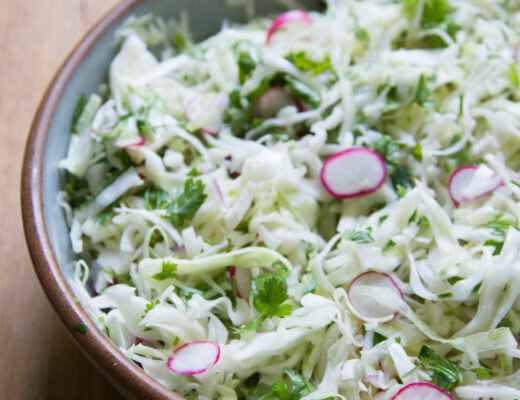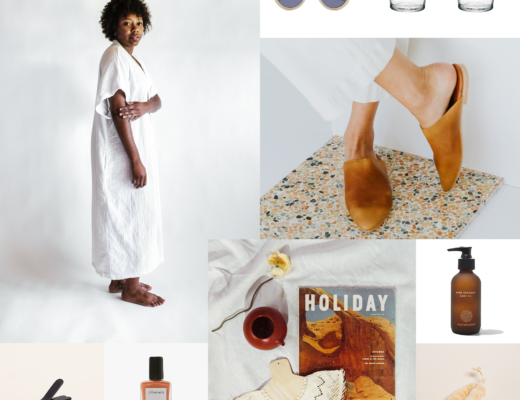Step Three: Slow Growth and Limiting Factors
You’ve figured out what to get rid of. Maybe you’ve honed in on a color palette. You’re working on building a solid base. But how do you begin to add the other pieces to love?
The best answer I have is slowly and with limiting factors. When you voluntarily limit the things you consume by self-imposing standards of construction or manufacturing or material, logic follows that you finish by consuming less.
Here are a few (alliterative but not alphabetical) rules of thumb that I consider as I shop:

Evaluate Ethics:
Maybe it goes without saying, but we’ve got a fast fashion problem on our hands; cheap clothes produced in ways that compromise just about everything and everyone involved in their production.
Faced with a list of all things one need evaluate in order to determine the ethics of a garment, one can quickly throw up her hands and declare, “I’ll just run around naked, then.”
While I’m quite sure that all of us are glorious sights to behold in the buff, I think it’s reasonable that society at large might expect us to be clothed. And so I can only suggest that we allow ourselves the time to consider the where and the what and the who of how something has been made and try our best to make choices that harm fewer people and ransack fewer precious resources.
It’s hard to tick every single box of what makes a perfectly ethical garment, but if you embrace shopping with a critical eye, chances are you’ll come out ahead.
Question Quality:
Cheap clothes rendered unwearable after the first wash quickly expose the affordability fallacy of fast fashion. But inexpensive clothes aren’t the only problem. Clothes at a range of price points can have questionable construction or dubious origins. And how very disheartening it is to splurge on something only to find that it’s been poorly made. So, make like your fussy grandmother and run your hand along those seams. Try things on before buying them. Lift your arms and check to make sure the arm holes are even. Hold t-shirts up to the light. Consider buying just one blouse before deciding you need the whole rainbow.
Factor in Fabrics:
I try hard to build my wardrobe with as many natural or naturally derived fabrics as possible. For me it’s often a question of feel: I prefer a rich wool or soft cotton to a polyester blend. But there are also other considerations of breathability and wear and environmental impact.
Forget Fads:
For me the key to a minimalist wardrobe is to turn a blind eye to at least some of the seasonal fads. I’m not saying I haven’t been a victim of fickle fashion. There’s that diary entry from 15-year-old me reporting that I wore a tie-dyed tube top with a pair of Jnco jeans and confiding that I “like to wear sexy-ish clothes.” YIKES. But terrible fashion choices of the past aside, I do find that the more I stick to simple, timeless looks, the more versatile my small warbdrobe becomes.
An amazing result of a rich online community is access to small-scale designers who can sell high-quality clothes direct to consumer. I am endlessly impressed by these small business owners—many of whom have supported this site over the years (just take a look at those sponsors to the right). A word to the wise: small businesses don’t always have the resources of larger outfits when it comes to returns and exchanges. Do your homework before splurging and double-check measurements and return policies. When possible, try the garment on in person or seek the opinion of a friend or, say, blogger, who has experience with the product. The bottom line: there are lots and lots of people doing things right. Who are your favorites?
Take Time:
Mull over your decisions. Impulse buys account for 99% of the clothes that I’ve allowed to take up space in my closet without getting enough back in return. Make a Pinterest page if you think it would help. Or tear pictures out of magazines and make an old-fashioned mood board. The point is to identify things that you think you’d love to own and then let the idea marinate for awhile before pulling out your wallet.
Okay. Your turn. What are your rules of thumb? And more importantly, where are you shopping?
A few good reads:
Ecouterre
Overdressed
A few good shopping resources:
Accompany
The American Edit
Zady




34 Comments
I love how much time you spend on considering new clothing. I probably have the same amount of room (or even less) of closet space and I am just now slowly admitting to having to start buying more cautiously.
The one thing that has truly helped has been to go shopping in person, and if I really want to buy the item of clothing, I put it on hold. I take pictures of the outfit and send it to someone who will actually be honest with their opinions. If they say yes I come back and try it one more time and make a final decision.
http://www.southernfolly.com
Love this series! 🙂 I don't have any suggestions as to where to shop. Since I live in Norway, the travel distance to the US probably zeroes out the ethical advantage of local brands here. But I have a book tip: "Women in clothes". Very enjoyable!
But I'll chime in on your rule of thumb of letting wishes linger. Research has shown that wishing for something gives as positive feelings as actually getting/having it. (I don't have the source right now.) And buying vintage. Clothes were just made sturdier before the 70s. But I even love second-hand from later decades, worn-in clothing feels so much better than new, chemically treated items (disregarding smells and stains, of course).
I do love that you're writing about this! I try to be more intentional in my wardrobe than I have been in the past, and I do love my Raleigh denim (http://raleighworkshop.com/about-us/).
I love this series you're doing! It's keeping me on track with a similar goal. I moved recently and used that great stressor to cull my wardrobe. I want to have a few beautiful pieces I'm proud to own and wear. As a small indie women's apparel designer, it's been a challenge to say goodbye to fancifully made frocks! I thought you might be interested in my page on natural fibers & how to care for them. I realized that not everyone has a rich background in fibers & preservation so I created a page all about that. It includes a bit of history on fibers as well. http://unabashedapparel.com/laundry-fiber-know-how/
Cheers to you & your lovely blog & this great series! Looking forward to more.
Sarahbeth – the page you put together is amazing! What a fantastic resource!
Beautiful work, Sarahbeth! (I have a hunch you'll be especially fond of "Step 4"—stay tuned!)
Thanks so much Lauren!
I'm looking forward to the next step Erin & thanks for the compliment!
Hi Erin!!
Love your blog – you've truly inspired me to live with less, but have those items I do keep be quality pieces. One thing that you've almost single-handedly sold me on is the importance of the quality of the products I put on my body. I'd love to see a round up/blog post on how to get started on using more natural products for hygiene and bathing, and where you get products that you buy and any books/etc. you've read that inspired you to do better. Thank you again! What an amazing blog!
Kaitlyn, in this post, the woman talks about a book she used to help her start making her own products. I've never seen it, but maybe it would work for you! http://joannagoddard.blogspot.com/2014/10/my-beauty-uniform.html
Thanks so much for your note, Kaitlyn! I'm working on those guys—stay tuned!
I adore this blog, and while I've warmed up to step three and gotten rid of so many items over the past several years, I still have things I hold onto for odd emotional reasons. ("It was expensive," or "it's pretty on the hanger," or "I love the color or print, even though it's tired or doesn't fit" or "it feels irreplaceable".) I'm trying to figure out how to let go of these things. I feel so ready to do it until I put my hands on the item, and then I am seized by the "once it's gone it's gone" fear for some of these things. I have fought my way through the emotional-clothing landmines with a fair amount of success, but the easy stuff is long gone and I'm stuck in the middle of the minefield with the harder decisions and the end seems far away! Which is to say: your post is hugely motivating. I am leaning heavily toward picking the best things that are a-in my limited palette and b-made from natural materials, and then seeing what's left. I suspect I'd be able to let a lot of it go at that point.
Thanks so much, Rebecca! Certainly don't break up with any long loves, but if there are more reasons not to have something than to have it….consider the donate pile!
Since I almost exclusively shop at second-hand shops, my criteria really boils down to two things:
1) Sturdy fabric
2) Pockets
My wardrobe might not be a minimalist one, but by golly I have somewhere to put my keys.
Pockets! (Had pockets sewn into my wedding dress!)
I find these points to be efficiently explained and spot on! The "shop small" one is good – ethical conditions are usually much better and quality often is higher, as owners of small businesses tend to put their heart in their products 🙂 It's also much more meaningful in a way, to buy from a small company, to meet the creator. I don't buy clothes online, but thankfully there are quite a few creator shops in Paris.
My rules of thumb are quite similar to yours – defining my own style and preferences (as opposed to following fashion), make meaningful purchases (in terms of ethics, the story behing the item…), always think twice before making a purchase, favour long-lasting quality and simplicity (accessories and jewelry can bring more diversity), know my body and how I like the clothes to look on me, and always question if there isn't already something I own that can do the same job.
Thanks, Kali! The bit about knowing your body and how you want clothes to look on you is a really good one!
I am always puzzled by the huge walk-in closets that are the most desired item in real estate these days. I can understand how people fill them but when do they wear all those things? Another rule of thumb to minimalize the wardrobe is to ask yourself cash or credit? Skip the credit purchases and see what happens. True that many purchases are made online, however, you can still ask the question. A side benefit you may also end up with some extra cash to, say, fly to Europe or something like that.
What I struggle with the most is finding professional, ethically manufactured clothing that I can afford. Most of the small, ethical clothing businesses that I see on blogs lean toward the very casual and when I do find professional clothing, the prices can be so high! I only need one or two work dressed but I can't afford to spend $600 on them.
Thank you for this piece. I love your framing of ethical considerations in clothing. I am always trying to figure out how to determine labor conditions of workers as a factor in my clothing choices. Beyond union made clothing which is rarer today I am not sure how to find out this information. Cheap prices are usually an indication that workers are not receiving livable wages or working in healthy conditions but high end clothes can use sweat shop labor as well. I also look at construction of the garment because things like double seams usually indicate a care in manufacturing that I translate as allowing people time to put effort and care into the product. Any other suggestions of how to determine ethical treatment of workers would be great.
I love your philosophy, Erin. As a recovering compulsive spender, your observations and advice make so much sense. Do you have any recommendations for smaller, ethical clothing companies that make plus sizes? So far, they are proving very hard to find. If only they knew the untapped market they are missing! Any ideas from you or your readers would be greatly appreciated!
(another) Erin
Great series! I had a bit of a revelation this summer during vacation, when for the first time in a long time I felt really confident in all my outfits, and realized it's because I packed my small suitcase so that I could mix and match everything. It caused some daring fashion moments (jean shirt over Hawaiian shirt!) but worked out so well that I'm editing my wardrobe down, using a similar philosophy to yours.
One happy consequence: less black!!
Pic of closet: http://instagram.com/p/th5kJnOPCX/?modal=true
I recently started sewing and as a result I've found myself paying A LOT more attention to garment construction/quality, especially seam finishes. I have to admit before learning to sew I didn't really know what good & bad seams looked like (unless they were coming apart) or that certain seams should be used on certain kinds of fabric. You might like this handy cheat sheet I found to help assess garment quality: http://into-mind.com/2014/05/04/how-to-assess-the-quality-of-garments-a-beginners-guide-cheat-sheet/
Loving this series, Erin! Thanks for the shout out! 🙂
Erin, what are your thoughts on Everlane? I've never purchased from them, but keep going back to their website over and over again. Do they seem to produce quality items?
Hi Mary,
I've been really pleased with their quality. James has a number of their oxfords which have been great and I really love my cashmere cardigan and v-necks! (I didn't totally love my seed stitch, but I think that has more to do with drape than quality)!
Thanks, that's helpful!
(I left a comment already but it didn't show up for some reason; sorry if it later appears and you see this twice!)
Hi Erin!
Do you know some good companies to buy work clothes from? The eco-friendly equivalents of Theory and LOFT perhaps? I've (slowly) purged all my fast fashion clothes so now I'm down to only a handful of outfits that I wear to work each week. I want to be mindful as I add more outfits into the mix but I don't know where to buy affordable, eco-friendly clothes that look really professional. Any suggestions would be much appreciated!
Thanks,
Annie
I just read this whole series and loved this post the most, as this subject is closest to my own heart. My rules of thumb are fairly similar. I love that you mention to shop small, because that's the best way to truly be sure of the ethics, quality (mostly), natural fabrics (often) and where your money is going to. Great series Erin!
As for brands and shops, I recently learned of kowtow (http://www.kowtowclothing.com/) whose collection I love. I also like Toast (http://www.toa.st/) and Betina Lou (shop.betinalou.com)!
Should you be a quicker person then you may find it difficult to discover clothes that will suit perfectly along with go well with a person. This guideline need to help you distinguish what exactly forms go well with quicker females along with help you put together a perfectly tiny tablet wardrobe best waist cincher on the market.
Very enjoyable! Love your blog so much 🙂
Just beginning your series and finally actually committing to minimizing my closets and minimalism for myself. One thing that has helped IMMENSELY is finding out what body silhouette I prefer my clothes to fit. It’s helped with purging so many of my clothes and throughout I’ve found my color palette. Weird how that worked out for me. Anyway, you may cover the body silhouette later in the series, but thought that’d be something great for your readers to know. Minimalism has helped me with self discovery and I wouldn’t have ever figured out my body silhouette without minimsizing. (: thank you so much for your site. It’s helped me and has substantial depth <33 the fact that you're a mama is just the cherry.
Love this point! Haven’t really ever talked about it explicitly, but it’s super clear from reader comments that different silhouettes speak to different people! Thank you!
Comments are moderated.